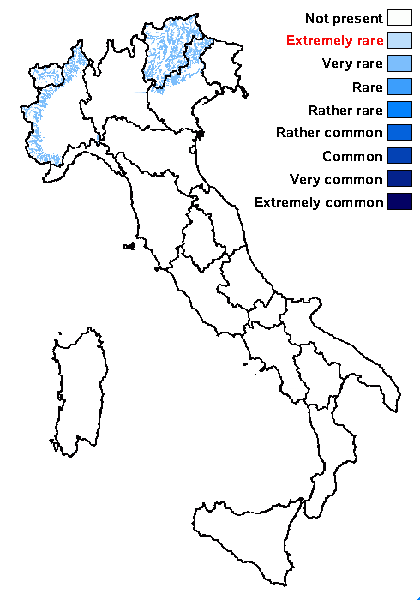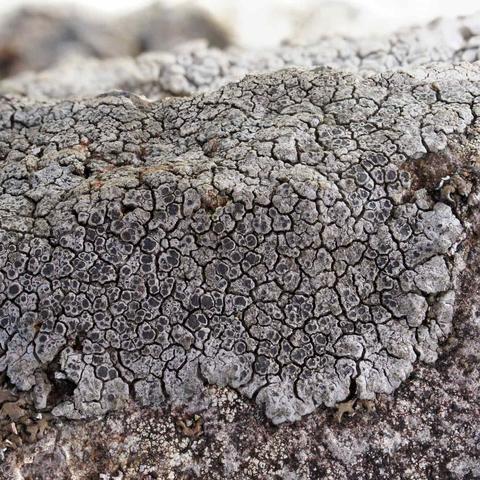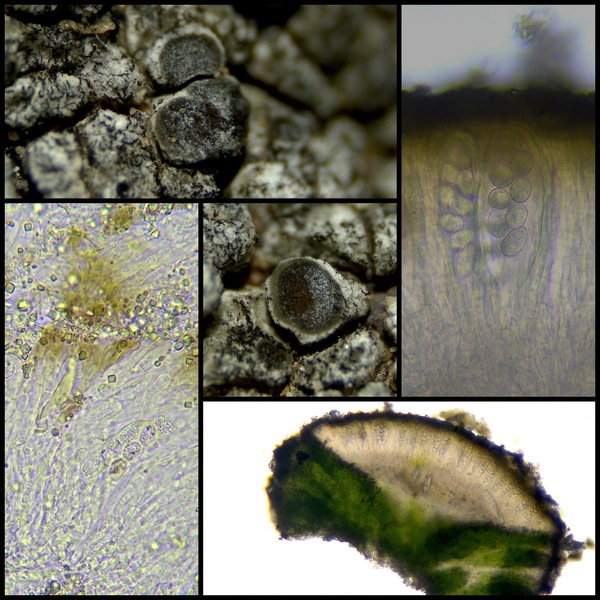Lobothallia recedens (Taylor) A. Nordin, Savić & Tibell
Mycologia, 102: 1346, 2010. Basionym: Lecidea recedens Taylor in Mackay - Fl. Hibern., 2: 117, 1836.
Synonyms: Aspicilia bohemica Körb.; Aspicilia polygonia var. pantherina A. Massal.?; Aspicilia recedens (Taylor) Arnold; Lecanora bohemica (Körb.) H. Magn.; Lecanora griseola Th. Fr.; Lecanora recedens (Taylor) Nyl.; Lecanora subcinerea Nyl.
Distribution: N - Ven, TAA (Nascimbene 2005), Piem (Isocrono & al. 2003, Giordani & al. 2014), VA (Piervittori & Isocrono 1999, Matteucci & Vanacore Falco 2015).
Description: Thallus crustose, episubstratic, thick, deeply cracked-areolate to verrucose, dark blue-grey to brown, sometimes with a brownish violet hue, often more or less white-pruinose, the areoles 0.5-2.5 mm wide, angular or the marginal ones rounded-wavy, with an uneven surface. Apothecia lecanorine-aspicilioid, 0.3-1 mm across, at first immersed in the areoles, later subsessile, often crowded (3-6 per areole), round to irregular by mutual compression, with a brown-black, matt, flat, often pseudogyrose disc, and a thin, sometimes radially cracked, finally often excluded thalline margin. Proper exciple pseudoparenchymatous; epithecium olive-green, N+ emerald green; hymenium colourless, 75-85(-100) μm high; paraphyses sparingly branched and anastomosing, moniliform, the apical cells up to c. 3 μm wide. Asci 8-spored, cylindrical-clavate, the thin outer coat K/I+ blue, the wall and apical dome K/I-. Ascospores 1-celled, hyaline, broadly ellipsoid, (9-)12-14 x 7-9 μm, thin-walled, often poorly developed. Pycnidia flask-skaped, with a dark punctiform ostiole and a colourless wall. Conidia bacilliform, 3-5 x c. 1 μm. Photobiont chlorococcoid. Spot tests: cortex and medulla K-, C-, KC-, P-, UV-. Chemistry: without lichen substances. Note: a lichen ranging from the boreal zone to the Mediterranean mountains, found on periodically wetted but rapidly drying siliceous rocks in upland areas. It is ecologically similar to Umbilicaria pustulata, and is probably more widespread in the Alps.
Growth form: Crustose
Substrata: rocks
Photobiont: green algae other than Trentepohlia
Reproductive strategy: mainly sexual
Commonnes-rarity: (info)
Alpine belt: absent
Subalpine belt: extremely rare
Oromediterranean belt: absent
Montane belt: very rare
Submediterranean belt: absent
Padanian area: absent
Humid submediterranean belt: absent
Humid mediterranean belt: absent
Dry mediterranean belt: absent

Predictive model
Herbarium samples
Growth form: Crustose
Substrata: rocks
Photobiont: green algae other than Trentepohlia
Reproductive strategy: mainly sexual
Commonnes-rarity: (info)
Alpine belt: absent
Subalpine belt: extremely rare
Oromediterranean belt: absent
Montane belt: very rare
Submediterranean belt: absent
Padanian area: absent
Humid submediterranean belt: absent
Humid mediterranean belt: absent
Dry mediterranean belt: absent

Predictive model
| Herbarium samples |
 INDEX FUNGORUM
INDEX FUNGORUM
 GBIF
GBIF
 DOLICHENS
DOLICHENS





